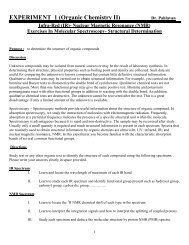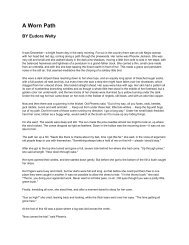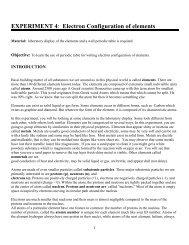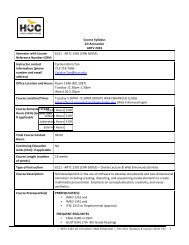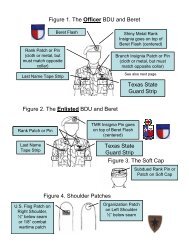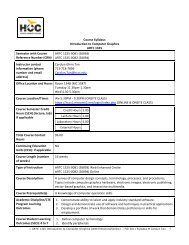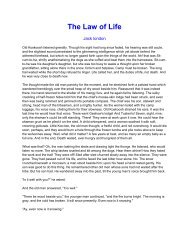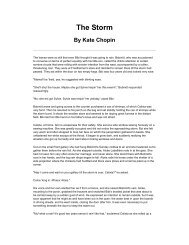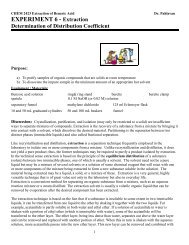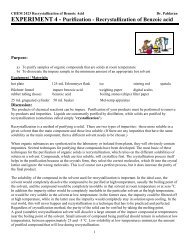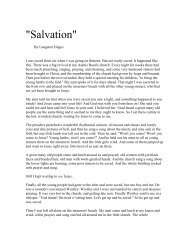EXPERIMENT 5 - Double Replacement Reactions
EXPERIMENT 5 - Double Replacement Reactions
EXPERIMENT 5 - Double Replacement Reactions
You also want an ePaper? Increase the reach of your titles
YUMPU automatically turns print PDFs into web optimized ePapers that Google loves.
<strong>EXPERIMENT</strong> 9: <strong>Double</strong> <strong>Replacement</strong> <strong>Reactions</strong>PURPOSEa) To identify the ions present in various aqueous solutions.b) To systematically combine solutions and identify the reactions that form precipitates and gases.c) To become familiar with writing equations for reactions, including net ionic equations.EQUIPMENT & CHEMICALSSpot plates (or small test tubes)Stirring rod or toothpicks0.1 M solutions of the following:AgNO 3 Ca(NO 3 ) 2 CuSO 4 Fe(NO 3 ) 3 HC 2 H 3 O 2 HCl K 2 CrO 4KI NaCl NaC 2 H 3 O 2 Na 2 CO 3 NaOH Na 2 S NH 4 ClPb(NO 3 ) 2INTRODUCTIONWhen one substance dissolves in another substance, a solution is formed. A solution is a homogeneousmixture in which the components are uniformly mixed. A solution consists of solute (the species that isdissolved) and solvent (the medium in which the solute has dissolved). The solvent is usually present inlarger amount than the solute. When water is the solvent, the solution is called an aqueous solution.When an ionic compound dissolves in water, it dissociates into its constituent ions. Such a compound is astrong electrolyte and conducts electricity well in dilute aqueous solutions. For example, when NaCldissolves in water, it dissociates into separate Na + and Cl – ions..This process occurs as polar water molecules orient themselves around the sodium and chloride ions andpull them free from the solid crystal. Once removed from the solid crystal, the ions remain separated andsurrounded by water molecules. There are no solid NaCl particles present, although in the solution,occasional contact between the Na + and Cl – ions, called ion pairing, does occur.The ability of a substance to dissolve is called its solubility. The solubility of a substance in water istypically defined as the mass of the substance that will dissolve in 100 mL of water. Solubility istemperature-dependent and usually increases for solid solutes dissolving in a liquid solvent.1
<strong>Double</strong> replacement reactions (also called “double displacement” or “exchange” or “metathesis”reactions) have the general formAX + BY BX + AY<strong>Double</strong> replacement reactions typically form a product that is either molecular or ionic. Molecularproducts such as H 2 O remain in solution and may not appear visually, but gaseous molecular substancessuch as CO 2 are usually identified easily by the appearance of bubbles and/or a new odor.A chemical reaction in which an insoluble product (or precipitate) forms is called a precipitationreaction. The reactants are usually soluble, but the product formed is insoluble and separates out as asolid.<strong>Reactions</strong> in aqueous solution can be written three ways:1) as the formula or “molecular” equation2) as the complete ionic equation3) as the net ionic equationA formula equation uses the normal formulas of the reactants and products. The complete ionicequation represents the formulas of soluble ionic compounds and strong electrolytes more realistically astheir separated positive and negative ions in solution. The net ionic equation is a simplified ionicequation in which the same ions appearing on both sides are omitted. Such ions are called spectator ionsbecause they undergo no chemical change themselves; they are only acting as “spectators” to the reaction.The net ionic equation contains the ions that do not “cancel” as spectator ions and products which aremolecular substances (nonelectrolytes such as water or a gas or a weak electrolyte such as acetic acid,HC 2 H 3 O 2 ), or as insoluble solids (such as PbI 2 ). If no substances or ions remain in the net ionic equation(all of the ions are spectators and cancel!) then there is no net reaction.Guidelines for Writing Formula EquationsStep 1. Write the reactants on the left side of your equation, taking care that their formulas are correct.Step 2. Following the pattern AX + BY → BX + AY, complete the reaction by writing the formulas ofthe products on the right side of your equation. Be sure all of the formulas are correct at this stage!Step 3. Next, balance your equation using coefficients in front of the formulas. The coefficients in aproperly balanced equation are the lowest possible whole numbers.Step 4. Now, indicate the physical state of each substance in your equation, (s), (l), (g), or (aq) forsolid, liquid, gas, or aqueous solution (dissolved). In this lab, each reactant substance is already inaqueous solution, so you can automatically indicate this using the “(aq)” label.How can you determine the physical states of the products? Your observations of the reactions willprovide valuable clues. If the mixture becomes cloudy due to the formation of tiny insoluble solidparticles which eventually settle or “precipitate” to the bottom of the reaction vessel, you know that asolid product formed (s).Which substance in your equation specifically is the solid? We refer to a table of solubility rules todetermine this (see below).2
If you observe the formation of bubbles, or notice a new odor, you know that one of the products is agaseous substance (g). Some gaseous products are CO 2 , NH 3 , and H 2 S.SOLUBILITY RULESOne of the factors driving a double replacement reaction is the formation of a solid precipitate. Aprecipitate is an insoluble solid compound formed during a chemical reaction in solution. To predictwhether a precipitate will form when you mix together two ionic reactants, you need to know whether anyof the possible products are insoluble. Considering the number of ionic compounds, it would be verydifficult to memorize the solubilities of so many compounds. Fortunately we can group compounds intosolubility categories. This is done with a set of rules called solubility rules.Solubility RulesRule StatementExceptions1All Group 1A and ammonium (NH 4 + )compounds are soluble.2 All nitrates (NO 3 – ) are soluble --3 Most acetates are soluble. AgC 2 H 3 O 2 *--4Most chlorides, bromides, and iodides aresoluble.AgCl, Hg 2 Cl 2 , PbCl 2 ,* AgBr, HgBr 2 , Hg 2 Br 2 ,PbBr 2 ,* AgI, HgI 2 ,Hg 2 I 2 , PbI 25 Most sulfates are soluble. CaSO 4 , SrSO 4 , BaSO 4 , Ag 2 SO 4 , Hg 2 SO 4 , PbSO 46 Most carbonates are insoluble. Group 1A carbonates, (NH 4 ) 2 CO 37 Most phosphates are insoluble. Group 1A phosphates, (NH 4 ) 3 PO 48 Most sulfides are insoluble. Group 1A sulfides, (NH 4 ) 2 S9 Most hydroxides are insoluble. Group 1A hydroxides, Sr(OH) 2 ,* Ba(OH) 2 *10 Most chromates are insoluble. Group 1A chromates, (NH 4 ) 2 CrO 4* Moderately solubleExample 1 – Formation of a Solid ProductLet us consider the reaction of an aqueous solution of NaCl with an aqueous solution of AgNO3. When weplace a few drops of the NaCl solution in the reaction container followed by a few drops of AgNO 3solution, we observe an immediate cloudiness (white precipitate) which indicates that a solid product hasformed. A precipitation chemical reaction has occurred.Following Steps 1-3 given above, the balanced equation for the reaction is,AgNO 3 + NaCl AgCl + NaNO 3Now we are ready for Step 4, the identification of the physical states of each substance. Referring to thesolubility rules, we determine that AgNO 3 is soluble (aq) because all nitrates are soluble (Rule 2). NaClis also soluble because all Group 1A compounds are soluble (Rule 1).Looking at the products, we see from the solubility rules that AgCl is insoluble (Rule 4 exception) andNaNO 3 is soluble (Rules 1 and 2). Therefore, the white precipitate that was observed is identified assilver chloride, AgCl.3
Adding the labels for the physical states, our reaction is now written,AgNO 3 (aq) + NaCl (aq)AgCl (s) + NaNO 3 (aq)Guidelines for Writing Complete Ionic EquationsThe complete ionic equation shows which reactants and products exist as separate positive and negativeions in solution and which do not. The steps for writing the complete ionic form of a reaction are asfollows:Step 1. First write the balanced formula equation following Steps 1-4 above. In the example above, thisis the reaction,AgNO 3 (aq) + NaCl (aq) AgCl (s) + NaNO 3 (aq)Step 2. All soluble ionic compounds are separated into their positive and negative ions. These are theionic compounds designated “(aq)” in the reaction. Molecular substances that are strong electrolytes (inparticular, strong acids such as HCl and HNO 3 ) are also separated into their positive and negative ions inaqueous solution.After Step 2, the above reaction becomes,Ag + (aq) + NO 3 – (aq) + Na + (aq) + Cl – (aq)AgCl (s) + Na + (aq) + NO 3 – (aq)As you can see, this is a much lengthier, but more correct, way of writing the reaction.Note that the solid product, AgCl, was not separated into its positive and negative ions. In the solid statethese ions are not separated from each other, so we do not separate them in the equation either. This isalways the case for solid reactants or products.The formulas of molecular substances such as H 2 O and CO 2 are also not separated into positive andnegative ions, for the same reason as with solids: these substances do not exist as separated positive andnegative ions. There are some exceptions as noted above: strong acids such as HCl and HNO 3 .A final category of substance whose formulas are not separated into positive and negative ions are weakelectrolytes. In aqueous solution, weak electrolytes separate into positive and negative ions only to avery small degree, and as such are essentially molecular in nature. An example is the weak acid aceticacid, HC 2 H 3 O 2 , which is the acid in vinegar.Guidelines for Writing the Net Ionic EquationThis is a simplified equation for the reaction that omits ions that are “spectators.” Spectator ions simplyremain in solution before and after the reaction. As such, they do not combine with another ion to forman insoluble solid, molecular, or weak electrolyte product.Step 1. Write the complete ionic equation as outlined above.Step 2. “Cancel” the ions that appear on both sides of the equation. In the above example, these“spectator” ions are crossed out:Ag + (aq) + NO 3 – (aq) + Na + (aq) + Cl – (aq)AgCl (s) + Na + (aq) + NO 3 – (aq)4
This leaves the net ionic equation,Ag + (aq) + Cl – (aq)AgCl (s)The spectator ions in this reaction are sodium ion, Na + , and nitrate ion, NO 3 – . They remained in solutionwithout forming any new product.The ions that do participate in the formation of the new product are called participating ions. In the abovereaction, Ag + and Cl – are the participating ions.Example 2 – Formation of a Weak ElectrolyteWeak electrolytes dissociate only to a small degree. Typically, an aqueous solution of a weak electrolytesuch as acetic acid contains mostly undissociated molecules with only 5% or less in dissociated form:HC 2 H 3 O 2 (aq) H + (aq) + C 2 H 3 O – 2 (aq)95% 5%Following is the reaction of hydrochloric acid (a strong acid) with sodium acetate:Formula Equation:HCl (aq) + NaC 2 H 3 O 2 (aq)HC 2 H 3 O 2 (aq) + NaCl (aq)Complete Ionic Equation:H + (aq) + Cl – (aq) + Na + (aq) + C 2 H 3 O 2 – (aq)HC 2 H 3 O 2 (aq) + Na + (aq) + Cl – (aq)Hydrochloric acid, HCl (aq), being a strong acid, is written in its dissociated form, H + (aq) + Cl – (aq).However, acetic acid, being a weak acid, is written in its undissociated, molecular form, HC 2 H 3 O 2 (aq).Net Ionic Equation:H + (aq) + C 2 H 3 O 2 – (aq)HC 2 H 3 O 2 (aq)Products that Decompose Upon FormationCertain products such as H 2 CO 3 (carbonic acid), H 2 SO 3 (sulfurous acid), and NH 4 OH (ammoniumhydroxide) are unstable in aqueous solution and immediately decompose according to the followingreactions:H 2 CO 3 (aq)H 2 SO 3 (aq)NH 4 OH (aq)CO 2 (g) + H 2 O (l)SO 2 (g) + H 2 O (l)NH 3 (g) + H 2 O (l)When these products form, you should write the decomposition products in your reactions. For example,the reaction,2 HCl (aq) + Na 2 SO 3 (aq) H 2 SO 3 (aq) + 2 NaCl (aq)should instead be written2 HCl (aq) + Na 2 SO 3 (aq) SO 2 (g) + H 2 O (l) + 2 NaCl (aq)5
Example 3 – Formation of a GasWhen aqueous solutions of hydrochloric acid and sodium carbonate are mixed, bubbles of a gaseousproduct are observed.Formula Equation:2 HCl (aq) + Na 2 CO 3 (aq) H 2 CO 3 (aq) + 2 NaCl (aq)The initial product, H 2 CO 3 , is a weak electrolyte and is also one of the unstable products that decompose,forming CO 2 and H 2 O, so the above equation becomes,2 HCl (aq) + Na 2 CO 3 (aq) CO 2 (g) + H 2 O (l) + 2 NaCl (aq)Complete Ionic Equation:Since CO 2 and H 2 O are molecular substances, we leave their formulas together. HCl is a strongelectrolyte, so it is separated into its positive and negative ion in solution. The compounds Na 2 CO 3 andNaCl are soluble ionic substances, so their formulas are correspondingly separated into their positive andnegative ions:2 H + (aq) + 2 Cl – (aq) + 2 Na + (aq) + CO 32– (aq) CO2 (g) + H 2 O (l) + 2 Na + (aq) + 2 Cl – (aq)Net Ionic Equation:Eliminating the spectator ions (Na + and Cl – ) from the ionic equation gives the net ionic equation:2 H + (aq) + CO 3 2– (aq) CO 2 (g) + H 2 O (l)Example 4 – Reaction with a Solid ReactantSolid hydroxide compounds, such as iron(III) hydroxide, react with hydrochloric acid.Molecular Equation:3 HCl (aq) + Fe(OH) 3 (s) FeCl 3 (aq) + 3 H 2 O (l)Complete Ionic Equation:3 H + (aq) + 3 Cl – (aq) + Fe(OH) 3 (s) Fe 3+ (aq) + 3 Cl – (aq) + 3 H 2 O (l)Since Fe(OH) 3 is insoluble (Rule 9), it is not separated into its positive and negative ions.Net Ionic Equation:3 H + (aq) + Fe(OH) 3 (s) Fe 3+ (aq) + 3 H 2 O (l)6
<strong>EXPERIMENT</strong>AL PROCEDUREWork individually (or in a group of 2) to carry out each of the reactions and note your observations. Thereactions may be done by combining each reactant in a test tube, or you may use a smaller scaleprocedure, adding a few drops of each reactant to the well of a spot plate.1. Obtain one clean spot plate (or obtain 10 clean small test tubes in a test tube rack). For each of thereactions indicated in your report sheet, add 4-5 drops of each of the two specified reactants and mixwell.If the solution turns cloudy, this is due to the formation of fine, suspended solid particles of a solidprecipitate. Formation of bubbles, and a new odor, is evidence of a gaseous product.2. Record your observations on the data sheet. If a reaction occurs, note the color of the solid formed aswell as any other observations. If no visible reaction is observed, indicate so on the report sheet.Note: Lack of a visible reaction does NOT guarantee that no reaction occurred. A soluble, colorlessproduct such as water will not be visually apparent.Do one reaction at a time and be very careful not to mix up droppers (if used) as this would lead tocontamination of the reagent bottles. The solutions are at a concentration of “0.10 M” or similar, where“M” stands for the concentration unit molarity, which means moles of solute per liter of solution.After completing all the reactions, but before disposing the contents of the test tubes or spot plates,discuss your observations with your lab partner and work together to write the formula equations on thereport sheet.3. For each reaction write the balanced molecular equation, complete ionic equation, and net ionicequation.7
Common IonsName Formula Charge Name Formula Charge Name Formula Chargealuminum Al 3+ +3 magnesium Mg 2+ +2 carbonate CO 32––2ammonium NH 4++1 manganese (II) Mn 2+ +2 chlorate ClO 3––1barium Ba 2+ +2 manganese (III) Mn 3+ +3 chloride Cl – –1cadmium Cd 2+ +2calcium Ca 2+ +2mercury (I)(mercurous){See note}mercury (II)(mercuric)Hg 2 2+ 2 X +1 chromate CrO 42–Hg 2+ +2 cyanate OCN – –1cesium Cs + +1 potassium K + +1 cyanide CN – –1chromium(II)chromium(III)cobalt (II)(cobaltous)cobalt (III)(cobaltic)cobalt (IV) Co 4+ +4copper (I)(cuprous)copper (II)(cupric)gold (I)(aurous)gold (III)(auric)hydrogen{See note}hydronium{See note}iron (II)(ferrous)iron (III)(ferric)lead (II)(plumbous)lead (IV)(plumbic)Cr 2+ +2 rubidium Rb + +1 dichromate Cr 2 O 72–Cr 3+ +3 scandium (III) Sc 3+ +3dihydrogenphosphateH 2 PO 4–Co 2+ +2 silver Ag + +1 fluoride F – –1Co 3+ +3 sodium Na + +1 hydroxide OH – –1Cu + +1tin (II)(stannous)tin (IV)(stannic)Sn 2+ +2 iodate IO 3–Sn 4+ +4 iodide I – –1Cu 2+ +2 titanium (II) Ti 2+ +2 nitrate NO 3–Au + +1 titanium (III) Ti 3+ +3 nitrite NO 2–Au 3+ +3 titanium (IV) Ti 4+ +4 nitride N 3– –3H + +1 vanadium (II) V 2+ +2 oxalate C 2 O 42–H 3 O + +1 vanadium (III) V 3+ +3 oxide O 2– –2Fe 2+ +2 vanadium (IV) V 4+ +4 permanganate MnO 4–Fe 3+ +3 zinc Zn 2+ +2 phosphate PO 43–Pb 2+ +2 acetate C 2 H 3 O 2 – –1 sulfate SO 42–Pb 4+ +4lithium Li + +1nickel(II)(nickelous)bicarbonate(hydrogencarbonate)bisulfate(hydrogensulfate)HCO 3–HSO 4–Ni 2+ +2 bromate BrO 3––1 sulfite SO 32––2–2–1–1–1–1–2–1–3–2–2–1 sulfide S 2– –2–1 thiocyanate SCN – –1potassium K + +1 bromide Br – –1 thiosulfate S 2 O 32––2A note about hydrogen and hydronium: Rarely does hydrogen ion exist on its own. When H + is written in equations or textbooks, it usually is a simplifiedway of saying H 3O + . Water, H 2O, is constantly breaking up to form trace amounts of hydroxide (OH - ) and hydronium (H 3O + ) ions.A note about mercury: Mercury (I) ion exists as a diatomic unit.8
<strong>EXPERIMENT</strong> 9: <strong>Double</strong> <strong>Replacement</strong> <strong>Reactions</strong>REPORT FORMName _______________________________Instructor ____________________________Date ________________________________1. barium chloride (aq) + sodium sulfate (aq)Observation:Balanced Formula Equation:Complete Ionic Equation:Net Ionic Equation:2. silver nitrate (aq) + sodium chloride (aq)Observation:Balanced Formula Equation:Complete Ionic Equation:Net Ionic Equation:3. lead(II) nitrate (aq) + potassium iodide (aq)Observation:Balanced Formula Equation:Complete Ionic Equation:Net Ionic Equation:9
4. sodium carbonate (aq) + hydrochloric acid (aq)Observation:Balanced Formula Equation:Complete Ionic Equation:Net Ionic Equation:5. sodium hydroxide (aq) + hydrochloric acid (aq)Observation:Balanced Formula Equation:Complete Ionic Equation:Net Ionic Equation:6. barium chloride (aq) + sodium carbonate (aq)Observation:Balanced Formula Equation:Complete Ionic Equation:Net Ionic Equation:10
7. sodium hydroxide (aq) + acetic acid (aq)Observation:Balanced Formula Equation:Complete Ionic Equation:Net Ionic Equation:8. sodium hydroxide (aq) + ammonium chloride (aq)Observation:Balanced Formula Equation:Complete Ionic Equation:Net Ionic Equation:9. lead(II) nitrate (aq) + sodium sulfide (aq)Observation:Balanced Formula Equation:Complete Ionic Equation:Net Ionic Equation:11
10. sodium sulfide (aq) + hydrochloric acid (aq)Observation:Balanced Formula Equation:Complete Ionic Equation:Net Ionic Equation:11. copper(II) sulfate (aq) + sodium hydroxide (aq)Observation:Balanced Formula Equation:Complete Ionic Equation:Net Ionic Equation:12. lead (II) nitrate (aq) + potassium chromate (aq)Observation:Balanced Formula Equation:Complete Ionic Equation:Net Ionic Equation:12
13. iron(III) nitrate (aq) + sodium hydroxide (aq)Observation:Balanced Formula Equation:Complete Ionic Equation:Net Ionic Equation:14. silver nitrate (aq) + sodium hydroxide (aq)Observation:Balanced Formula Equation:Complete Ionic Equation:Net Ionic Equation:15. sodium chloride (aq) + calcium nitrate (aq)Observation:Balanced Formula Equation:Complete Ionic Equation:Net Ionic Equation:13
<strong>EXPERIMENT</strong> 9Name:Pre-Laboratory Questions and ExercisesDue before lab begins. Answer in the space provided.1. Write the positive and negative ions that result when the following compounds are dissolved inaqueous solution:CaCl 2 (aq)Na 2 S (aq)(NH 4 ) 2 CO 3 (aq)K 2 SO 4 (aq)Ca 2+ (aq) + 2 Cl – (aq)__________________________________________________________________________________________________________________________________________2. Using the solubility rules, predict the solubility of each of the following compounds in water.(aq = soluble (aqueous solution), s = insoluble solid)a) CaCO 3 ______ b) Al(OH) 3 ______ c) Hg 2 Cl 2 ______ d) Cu(NO 3 ) 2 ______3. Write the complete ionic and net ionic equations for the following reaction:Pb(NO 3 ) 2 (aq) + 2 NaI (aq)PbI 2 (s) + 2 NaNO 3 (aq)Complete Ionic Equation:Net Ionic Equation:14



